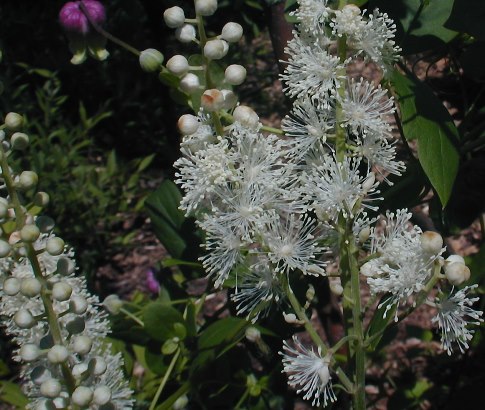Herbs , perennial, from hard, knotted, long-lived rhizomes. Leaves basal and cauline, compound, petiolate with basal wings clasping stem; cauline leaves alternate. Leaf blade 1-3-ternately compound; leaflets ovate-lanceolate to broadly obovate or orbiculate, 2-5-lobed, lobe margins toothed or shallow to deeply incised. Inflorescences terminal, many-flowered panicles of racemelike branches [spikes in Asian spp.], 7-60 cm; bracts 1 or 3, alternate, subtending pedicel (pedicels bracteolate in C . americana ), not forming involucre. Flowers bisexual [unisexual], radially symmetric; sepals not persistent in fruit, (2-)4-5(-6), greenish white or cream to greenish yellow, sometimes pinkish or tinged with red, plane or ± concave, ovate to obovate, 3-6 mm; petals 0-8, distinct, white or yellowish, plane, apex 2-cleft [entire], sometimes clawed, 3-6 mm; nectariferous area sometimes present; stamens 20-110; filaments filiform [flattened]; staminodes absent between stamens and pistils; pistils 1-8, simple; ovules 4-15 per pistil; style present. Fruits follicles, usually aggregate, sessile or stipitate, ovoid to obovoid, weakly to strongly compressed, sides not prominently veined; beak terminal, straight or hooked at tip, 0.5-2.5 mm. Seeds pale brown to reddish or purplish brown, angled or laterally compressed, hemispheric, lenticular, or cylindric, smooth, slightly ridged, verrucose, or densely scaly. x = 8.
Cimicifuga may be divided into two natural groups: those with seeds scaly and those with seeds lacking scales or nearly so. Cimicifuga racemosa and C . elata of North America, with scaleless seeds, are most closely related to C . biternata (Siebold & Zuccarini) Miquel and C . japonica (Thunberg) Sprengel of Asia.
Four or five species of Cimicifuga are cultivated as ornamentals, and at least five named cultivars have been developed.
Sep 4-5, petaloid, very convex, caducous; pet none; stamens very numerous, with long, white filaments and rounded or obovoid anthers, a few of the outermost usually transformed into expanded, 2-horned staminodes; pistils 1 or more; follicles several-seeded; tall perennial poisonous herbs with few, large, commonly basally disposed, ternately or pinnately compound or decompound lvs, broad lfls, and erect, elongate, many-fld racemes or panicles. 20, N. Hemisphere.
Gleason, Henry A. & Cronquist, Arthur J. 1991. Manual of vascular plants of northeastern United States and adjacent Canada. lxxv + 910 pp.
©The New York Botanical Garden. All rights reserved. Used by permission.




